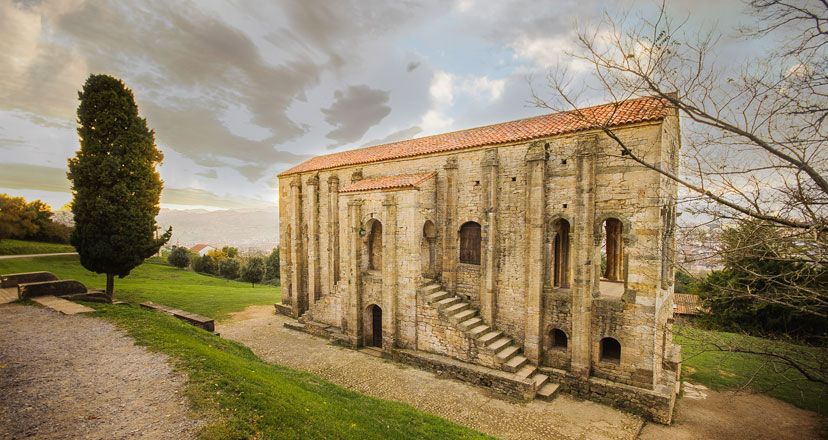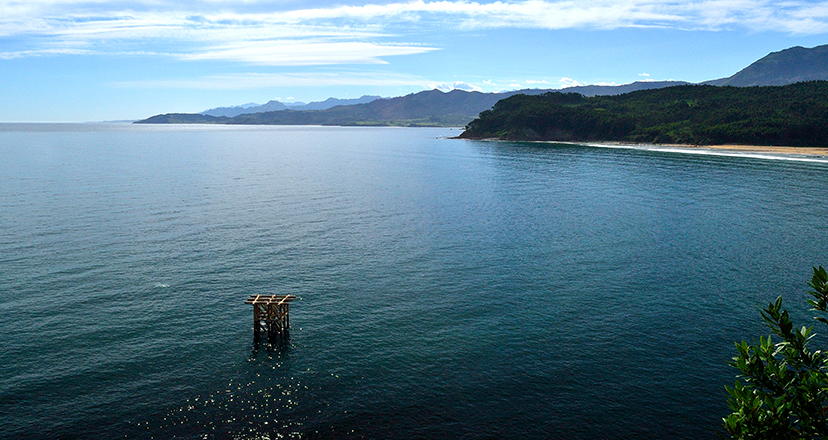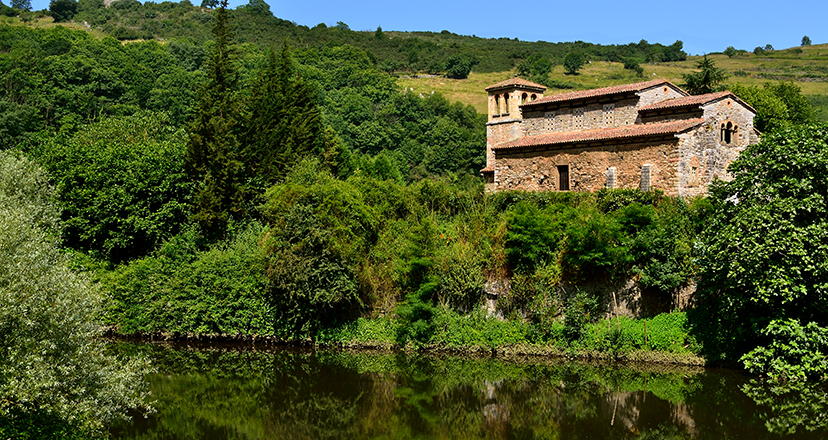Back The best places to get to know the Asturian Pre-Romanesque period
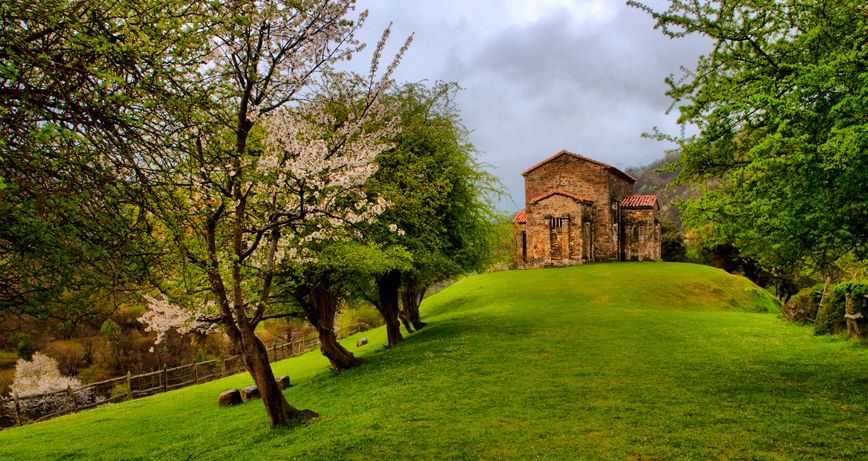
The essential places to visit in the Asturian Pre-Romanesque period
An itinerary through Asturian Pre-Romanesque Art is a fascinating journey into the past and the present, amidst architecture and landscapes that will totally captivate you.
A route through Asturian Pre-Romanesque Art is much more than a history lesson. It is an entertaining journey into the past where you will make fascinating discoveries, and where you will enjoy all that the present has to offer: the cities in which some monuments stand, or the wonderful natural and rural surroundings in which others are located.
Between vaulted ceilings, semicircular arches, sogueadas columns, pillars, decoration with latticework or iconostasis, you will immerse yourself in the incredible world of a small and at the same time courageous medieval kingdom, linked to European culture and full of spirituality: the ancient kingdom of Asturias.
And so, between churches and cathedrals or ancient palaces, you will enter into the Asturian soul. As well as medieval architecture, you will discover landscapes, corners, legends, local people who will tell you stories, wineries where you can eat great food, bar-shops where you can buy the best cheese, towns and villages full of life, pilgrims who have come from all over the world to walk the Camino de Santiago... Memories, emotions, moments, experiences, sensations... A world of dreams and reveries that will touch your heart from the utopia of a kingdom that even today leaves you astonished by its serene beauty.
For all these reasons and some more that you will discover en route, we suggest some essential visits to get closer to Asturian Pre-Romanesque Art.
Colunga, the pre-Romanesque town in love with the waves of the sea
From Cangues d'Onís/Cangas de Onís you can reach the eastern coast of Asturias straight away, and head for the council of Colunga. Once there, you will find the village of Gobiendes, which stretches out its arms in a staggered form with the aim of reaching the sea. In fact, this quiet village is a splendid vantage point overlooking the coast, and offers splendid views of the Sueve mountain range, the highest and closest altitude to the Bay of Biscay in Asturias.
And so, in a peaceful, rural Asturian setting, at the highest point of the village, stands Santiago de Gobiendes, a pre-Romanesque temple, which has undergone some changes over the years, but which preserves original elements and is one of the most outstanding examples of late pre-Romanesque art (dating from around the 10th century).
Villaviciosa, the living spirit of the Pilgrims' Route to Santiago de Compostela
From Colunga you can head for the neighbouring council of Villaviciosa, and make a stop in San Salvador de Priesca, an idyllic place with a pre-Romanesque church, also from the 10th century, located in the middle of the Pilgrims' Route to Santiago de Compostela. It also has the peculiarity of being the last of the buildings of Pre-Romanesque art to have survived to the present day.
Due to its privileged location on a hill, on clear days it offers beautiful views over the Villaviciosa estuary, from which it is only a few kilometres away.
After a stroll through the village of Priesca, where it is not unusual to come across a pilgrim on the Pilgrim's Way, you can go on to Villaviciosa, the capital of the council, which has a splendid historic quarter and a great atmosphere linked to the apple and cider culture.
Of course, before entering the capital of the council, you can go to San Andrés de Bedriñana, and enjoy another sweet moment with the Pre-Romanesque Art.
Once you have visited the town, your next stop will be San Salvador de Valdediós, a church popularly known as "El Coventín", and considered the last great work of Asturian Art to remain for posterity. The truth is that Valdediós has a very special interest for what it means as a compendium of the art developed in Asturias in its hundred years of creativity, and also for what it represents as an opening to the new Mozarabic style, which also announces more than a century in advance what will be the first European Romanesque art.
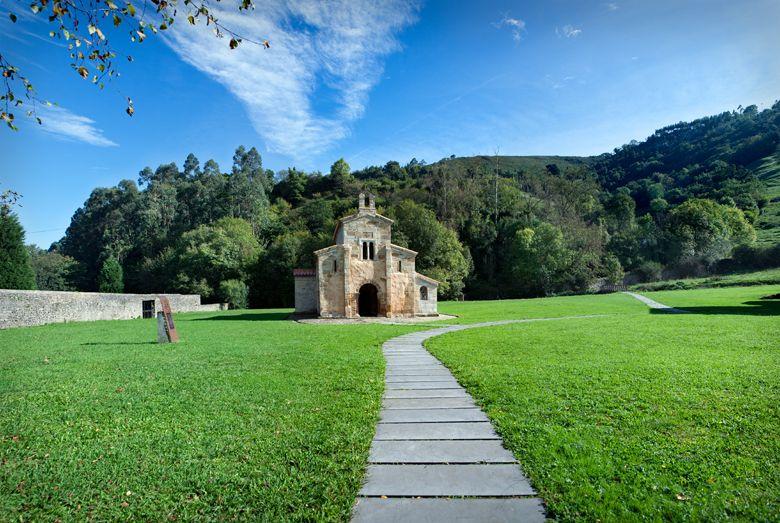
Built by Alfonso III the Great - where this monarch lived his last years -, it seems that the complex was made up of a palace and other outbuildings, similar to the palace complexes that existed in Oviedo/Uviéu and on Monte Naranco.
Today the Conventín stands tall, withstanding the passage of time and pilgrims in the "Valley of God", with the Carmelite monastery of Santa María de Valdediós nearby.
The peace and tranquillity that you will breathe in this place will make you never want to leave.
Pravia, the reminiscences of a quiet court
To continue with the peaceful tone of your trip, nothing better than to head for Pravia, capital of the council of the same name, whose streets, squares, churches, collegiate churches and palaces clearly conserve the reminiscences of what was once a cultured, devout and peaceful court.
It was King Silo who established the court in Pravia in 774, in the 8th century, as you will read in the statue that pays homage to this king of Asturias in the very square of the Collegiate Church of Pravia.
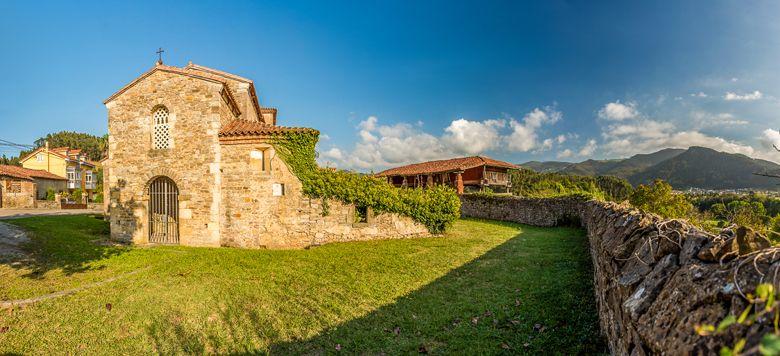
A few kilometres from the royal capital is the church of San Juan de Santianes de Pravia, considered the oldest in Asturias and which was erected by the will of King Silo and his wife Adosinda (where they are also buried, according to the chronicles). When you look at it, you will be discovering one of the earliest examples of Pre-Romanesque art. The surroundings of the church are enveloping, despite the fact that the artisan complex, which was completed with a royal palace, has not been preserved. A beautiful rural landscape, a bread basket, splendid views, the colourful houses of the nearby indianos, the presence of a palace in the surrounding area, and the proximity of the Pre-Romanesque Museum make this historic monument completely captivate you.
Oviedo, the "regia sedes" dreamed of by Alfonso II
From Pravia to Oviedo/Uviéu, the route is simple and beautiful, and as soon as you set foot in the capital of Asturias, you will realise its royal bearing. Oviedo/Uviéu was the great capital of the Kingdom of Asturias thanks to the strategic vision of King Alfonso II, nicknamed the Chaste, because he looked more like a monk than a worldly king.
The city still preserves the spirit of "Regia Sedes" with which Alfonso conceived it and there are numerous vestiges of that court in the historic centre of Oviedo, the most outstanding being the Holy Chamber of the Cathedral of Oviedo/Uviéu and San Tirso el Real. Outside the historic centre itself, you can also visit the Church of San Julián de los Prados and the Foncalada Fountain.
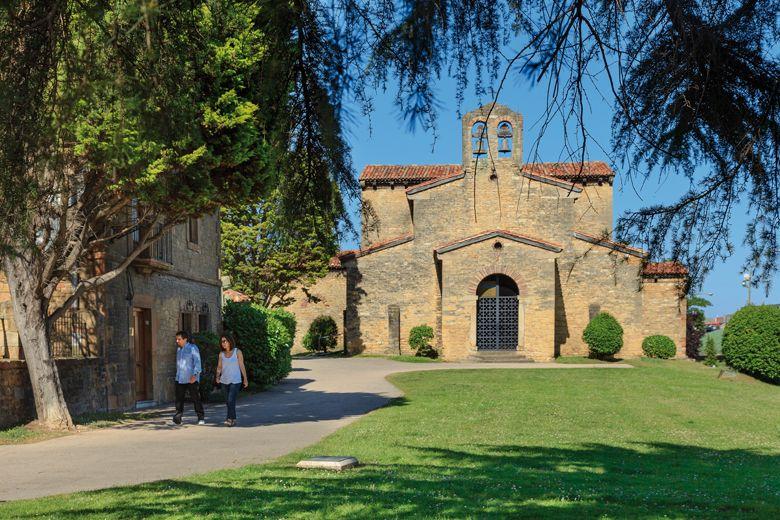
Oviedo/Uviéu is today a modern and hospitable city, where you will experience the Pilgrim's Way in a very special way because it was here that the Way of St. James was born, and its architect was precisely Alfonso II.
The historic centre is always lively, with its museums, its squares, the Fontán market, its shops, its terraces, its bars and restaurants, its travellers and pilgrims... It is a continuous and cheerful wandering that will infect you with positive energy, and at the same time you will talk face to face with the history of the kingdom.
Monte Naranco, a place for relaxation
On the outskirts of Oviedo/Uviéu and at the foot of Mount Naranco, one of the natural lungs of the city, you will find the two most famous pre-Romanesque jewels in the history of the Kingdom of Asturias: Santa María del Naranco and San Miguel de Lillo.
Today, Monte Naranco continues to be a place for relaxation and recreation not only for the people of Oviedo, but for all Asturians and for all travellers and visitors to the area. So when you go to Monte Naranco you must make a stop at the site of these two monuments.
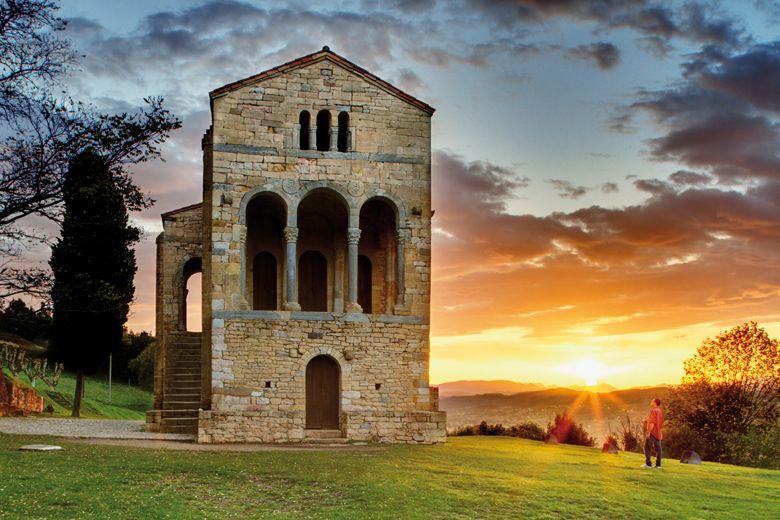
Santa María del Naranco - which had a palatial use and was later sacralised - is the most brilliant exponent of European Pre-Romanesque Art. From the meadow that surrounds it you have splendid views of the city of Oviedo/Uviéu. And just a hundred metres away stands San Miguel de Lillo, where Ramiro I, the monarch who ordered the construction of both churches, used to go to mass.
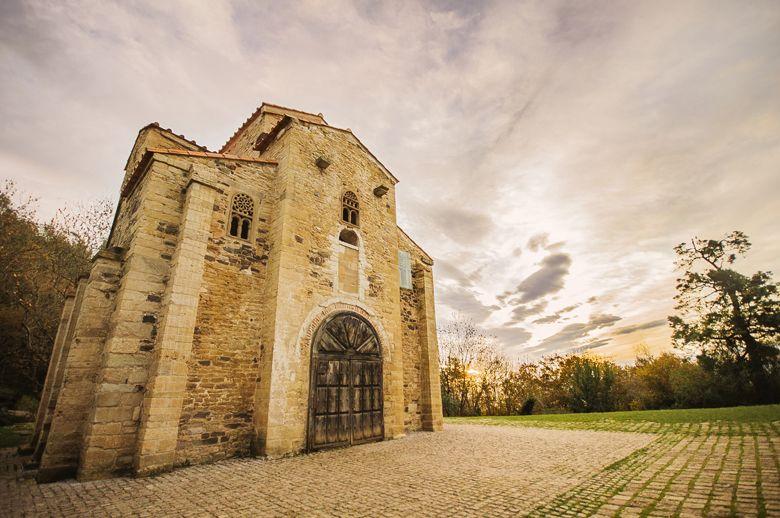
A day on Monte Naranco will surely be as pleasant for you as it was for the king and his court when they travelled here from Oviedo/Uviéu.
You will also enjoy contemplating two monuments that have been declared World Heritage Sites by UNESCO (as well as the Cámara Santa, the church of Santullano and the Foncalada fountain in Oviedo/Uviéu).
Here, at the foot of Naranco, you can also visit the Asturias Pre-Romanesque Interpretation Centre. With the help of maps, chronograms and photographs, you can take a tour of the different stages of Asturian pre-Romanesque art and all the monuments, using interpretive panels. There are also workshops for children.
Bendones, where a pre-Romanesque jewel stands overlooking the Aramo Mountains
Bendones is a quiet and welcoming village a few kilometres from Oviedo/Uviéu. For many centuries - specifically since the 9th century - it has housed in one of its most attractive corners a jewel of Pre-Romanesque Art built in the 9th century, during the reign of Alfonso II: Santa María de Bendones.
The church, which, as with other works of Pre-Romanesque art, suffered historical vicissitudes (especially in the 20th century) that reduced its original structure, is still standing today after its reconstruction and seems to be an example of resistance.
In the heart of the village, it looks up to the sky and the imposing Sierra del Aramo mountain range, in a rural and peaceful setting that will be unforgettable.
San Pedro de Nora, royal art on the riverbank
From Bendones you can head towards Las Regueras, to reach San Pedro de Nora. The place where this church is located is an idyllic spot at the foot of the river, so that on sunny days the whole pre-Romanesque silhouette of the sacred building is reflected in the riverbed of the Nora, as if it were an artistic painting.
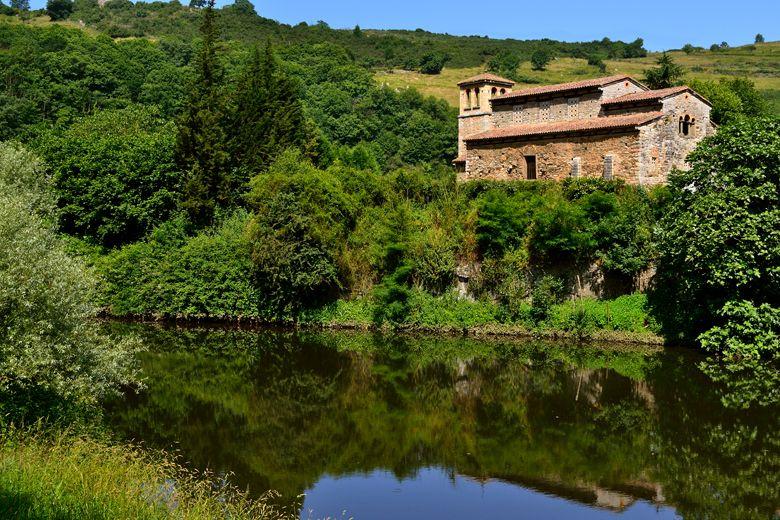
San Pedro de Nora is another of the legacies of the reign of Alfonso II, and like all the others, it has a privileged location, and allows you a tour of great cultural and scenic intensity: you can visit the Roman baths of Valduno, the meanders of the Nora - which are a wonderful natural spectacle -, stroll through the emblematic and Jacobean Gallegos Bridge and even chat with some pilgrims that you find on your way...
Santo Adriano de Tuñón, under the influence of the brown bear
From the magical effluvium of the Nora, you can head for the Trubia Valleys, and stop off in the town of Tuñón, where on a quiet stroll you will find the abbey of Santo Adriano de Tuñón, which was founded at the end of the 9th century by Alfonso III the Great and his wife Jimena, and represents one of the last pre-Romanesque constructions erected during the two centuries of the Asturian monarchy.
Santo Adriano is set in a spectacular natural setting, close to the river and with the Senda del Oso (Bear Trail) as a faithful companion, which helps to enliven the area with lovers of hiking and cycling, as well as nature and culture enthusiasts. So Tuñón has a year-round atmosphere as it is the start of the Senda del Oso, and has been home to a pre-Romanesque treasure for more than a thousand years.
Santa Cristina de Lena, the Crown Jewel
From the Trubia Valleys you can cross the Alto de La Cobertoria to La Pola, capital of the council of Lena, and from there reach the beautiful church of Santa Cristina de Lena, which will be the last great landmark on your pre-Romanesque route.
Located in an idyllic spot, on the top of a hill, overlooking the valley of the river Lena, Santa Cristina seems to be timeless. Experts say that it was built in the 9th century, during the reign of Ramiro I.
The sweet Santa Cristina, known as the one with a thousand corners, due to the numerous inlets and protrusions in the frame of its reduced proportions, seems to be a guardian of the valleys, the mountains and the roads, those that have linked Asturias with the Meseta since time immemorial.
Observing her calmly, the same calm that she radiates, Santa Cristina (which appears in our cover photo) seems to whisper to you that she keeps unspeakable secrets...
And so, calmly, as you began, you will finish your route through Asturian Pre-Romanesque Art!
A route through Asturian Pre-Romanesque Art is much more than a history lesson. It is an entertaining journey into the past where you will make fascinating discoveries, and where you will enjoy all that the present has to offer: the cities in which some monuments stand, or the wonderful natural and rural surroundings in which others are located.
Between vaulted ceilings, semicircular arches, sogueadas columns, pillars, decoration with latticework or iconostasis, you will immerse yourself in the incredible world of a small and at the same time courageous medieval kingdom, linked to European culture and full of spirituality: the ancient kingdom of Asturias.
And so, between churches and cathedrals or ancient palaces, you will enter into the Asturian soul. As well as medieval architecture, you will discover landscapes, corners, legends, local people who will tell you stories, wineries where you can eat great food, bar-shops where you can buy the best cheese, towns and villages full of life, pilgrims who have come from all over the world to walk the Camino de Santiago... Memories, emotions, moments, experiences, sensations... A world of dreams and reveries that will touch your heart from the utopia of a kingdom that even today leaves you astonished by its serene beauty.
For all these reasons and some more that you will discover en route, we suggest some essential visits to get closer to Asturian Pre-Romanesque Art.
Colunga, the pre-Romanesque in love with the waves of the sea
From Cangues d'Onís/Cangas de Onís you can reach the eastern coast of Asturias straight away, and set sail for the council of Colunga. Once there, you will find the village of Gobiendes, which stretches out its arms in a staggered form with the aim of reaching the sea. In fact, this peaceful village is a splendid vantage point overlooking the coast, while offering splendid views of the Sueve mountain range, the highest and closest altitude to the Bay of Biscay in the whole of Asturias.
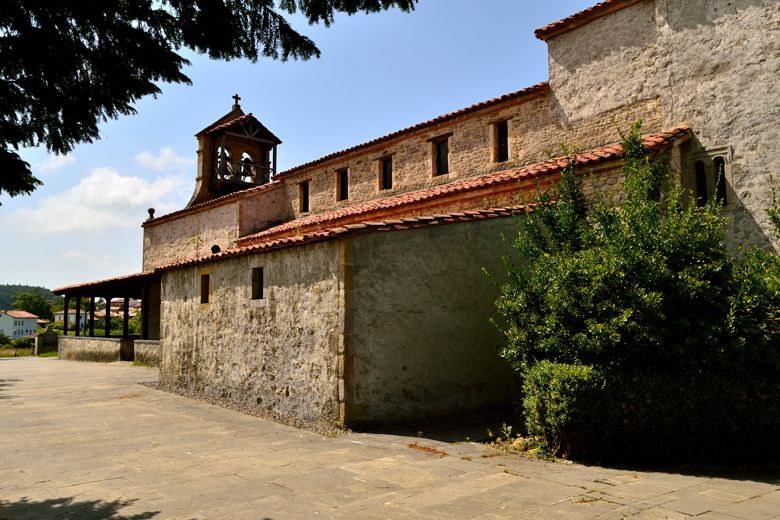
And so, in a peaceful, rural Asturian setting, at the highest point of the village, stands Santiago de Gobiendes, a pre-Romanesque temple, which has undergone some changes over the years, but which preserves original elements and is one of the most outstanding examples of late pre-Romanesque art (it dates from around the 10th century).
Villaviciosa, the living spirit of the Pilgrims' Route to Santiago de Compostela
From Colunga you can head for the neighbouring council of Villaviciosa, and make a stop in San Salvador de Priesca, an idyllic place with a pre-Romanesque church, also dating from the 10th century, located right in the middle of the Pilgrim's Way. It also has the peculiarity of being the last of the buildings of pre-Romanesque art that has survived to the present day.
Due to its privileged location on a hill, on clear days it offers beautiful views over the Villaviciosa estuary, from which it is only a few kilometres away.
After a stroll through the village of Priesca, where it is not unusual to come across a pilgrim on the Pilgrim's Way, you can go on to Villaviciosa, the capital of the council, which has a splendid historic quarter and a great atmosphere linked to the apple and cider culture.
Of course, before entering the capital of the council, you can go to San Andrés de Bedriñana, and enjoy another sweet moment with the Pre-Romanesque Art.
Once you have visited the town, your next stop will be San Salvador de Valdediós, a church popularly known as "El Coventín", and considered the last great work of Asturian Art to remain for posterity. The truth is that Valdediós has a very special interest for what it means as a compendium of the art developed in Asturias in its hundred years of creativity, and also for what it represents as an opening to the new Mozarabic style, which also announces more than a century in advance what will be the first European Romanesque art.
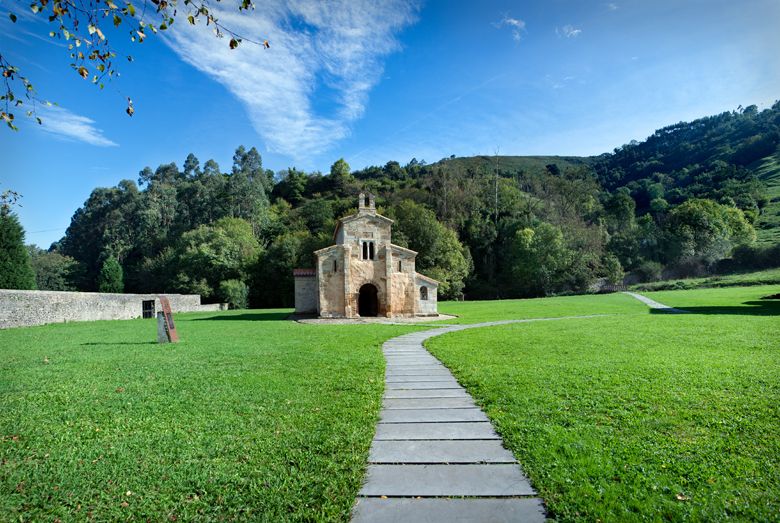
Built by Alfonso III the Great - where this monarch lived his last years -, it seems that the complex was made up of a palace and other outbuildings, similar to the palace complexes that existed in Oviedo/Uviéu and on Monte Naranco.
Today the Conventín stands tall, withstanding the passage of time and pilgrims in the "Valley of God", with the Carmelite monastery of Santa María de Valdediós nearby.
The peace and tranquillity that you will breathe in this place will make you never want to leave.
Pravia, reminiscent of a peaceful court
To continue with the peaceful tone of your trip, nothing better than to head for Pravia, capital of the council of the same name, whose streets, squares, churches, collegiate churches and palaces clearly conserve the reminiscences of what was once a cultured, devout and peaceful court.
It was King Silo who established the court in Pravia in 774, in the middle of the 8th century, as you will read in the statue that pays homage to this king of Asturias in the very square of the Collegiate Church of Pravia.
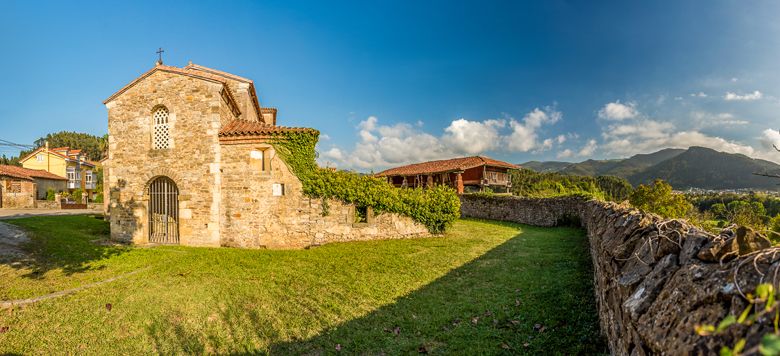
A few kilometres from the royal capital is the church of San Juan de Santianes de Pravia, considered the oldest in Asturias and which was erected by the will of King Silo and his wife Adosinda (where they are also buried, according to the chronicles). When you look at it, you will be discovering one of the earliest examples of Pre-Romanesque art. The surroundings of the church are enveloping, despite the fact that the artisan complex, which was completed with a royal palace, has not been preserved. A beautiful rural landscape, a bread basket, splendid views, the colourful houses of the nearby indianos, the presence of a palace in the surrounding area, and the proximity of the Pre-Romanesque Museum make this historic monument completely captivating.
Oviedo, the "regia sedes" dreamed of by Alfonso II
From Pravia to Oviedo/Uviéu, the route is simple and beautiful, and as soon as you set foot in the capital of Asturias, you will realise its royal bearing. Oviedo/Uviéu was the great capital of the Kingdom of Asturias thanks to the strategic vision of King Alfonso II, nicknamed the Chaste, because he was more like a monk than a worldly king.
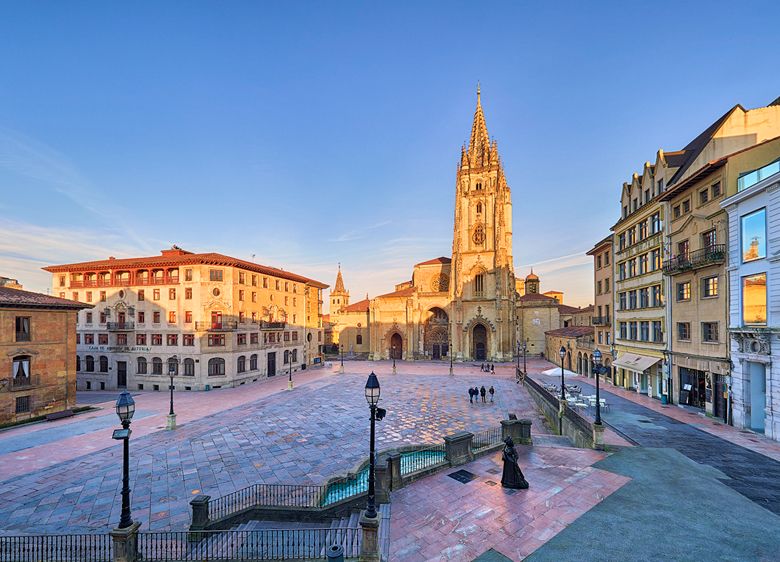
The city still preserves today the spirit of "Regia Sedes" with which Alfonso conceived it and there are numerous vestiges of that court in the historic centre of Oviedo, the most outstanding being the Holy Chamber of Oviedo/Uviéu Cathedral and San Tirso el Real. Outside the historic centre itself, you can also visit the Church of San Julián de los Prados and the Foncalada Fountain.
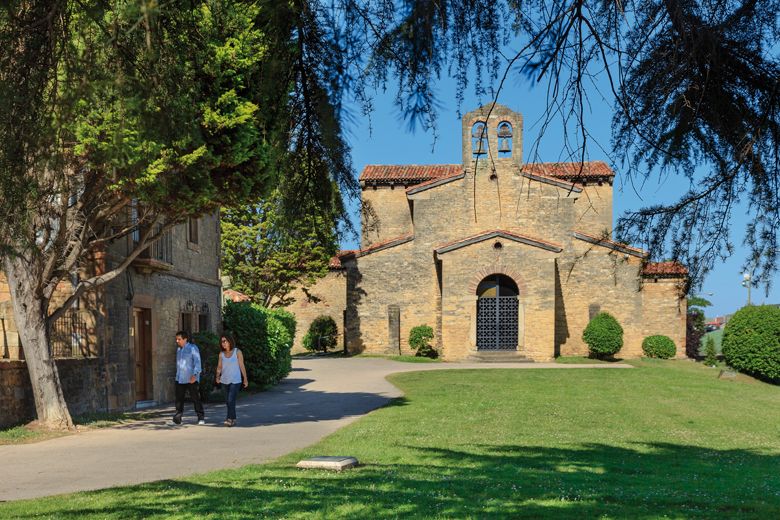
Oviedo/Uviéu is today a modern and hospitable city, where you will experience the Jacobean route in a very special way because it was here that the Way of St. James was born, and its architect was precisely Alfonso II.
The historic centre is always lively, with its museums, its squares, the Fontán market, its shops, its terraces, its bars and restaurants, its travellers and pilgrims... It is a continuous and cheerful wandering that will infect you with positive energy, and at the same time you will talk face to face with the history of the kingdom.
Monte Naranco, a place for relaxation
On the outskirts of Oviedo/Uviéu and at the foot of Monte Naranco, one of the natural lungs of the city, you will find the two most famous pre-Romanesque jewels in the history of the Kingdom of Asturias: Santa María del Naranco and San Miguel de Lillo.
Today, Monte Naranco continues to be a place for relaxation and recreation not only for the people of Oviedo, but for all Asturians and for all travellers and visitors to the area. So when you go to Monte Naranco you have to make a stop at the site of these two monuments.
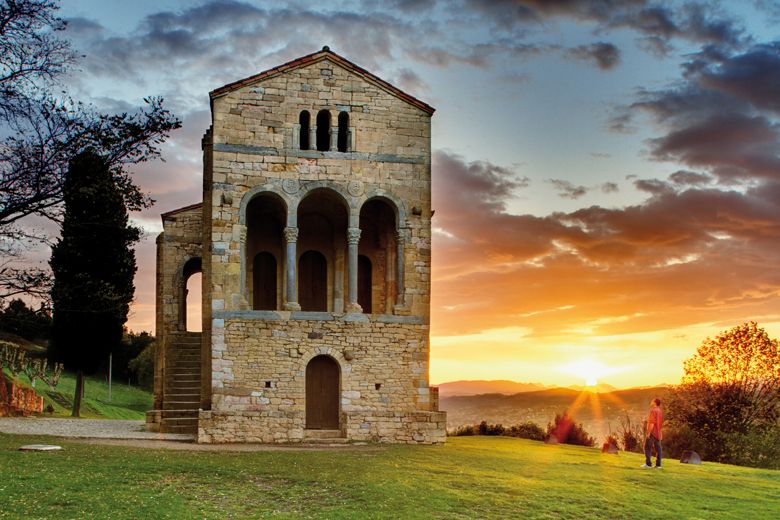
Santa María del Naranco - which had a palatial use and was later sacralised - is the most brilliant exponent of European Pre-Romanesque Art. From the meadow that surrounds it you have splendid views of the city of Oviedo/Uviéu. And just a hundred metres away stands San Miguel de Lillo, where Ramiro I, the monarch who ordered the construction of both churches, used to go to mass.
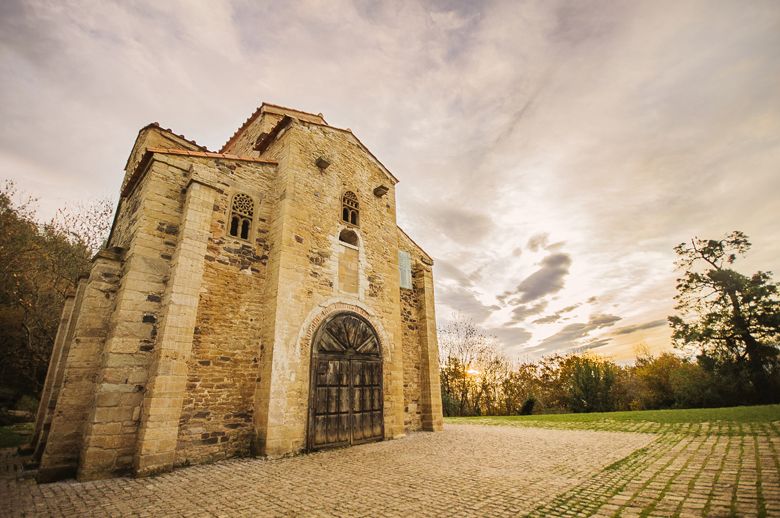
A day at Monte Naranco will surely be as pleasant for you as it was for the king and his court when they travelled here from Oviedo/Uviéu.
You will also enjoy contemplating two monuments that have the UNESCO World Heritage designation (as well as the Cámara Santa, the church of Santullano and the Foncalada fountain in Oviedo/Uviéu).
Here, at the foot of Naranco, you can also visit the Asturias Pre-Romanesque Interpretation Centre. With the help of maps, chronograms and photographs, you can take a tour of the different stages of Asturian pre-Romanesque art and all the monuments, using interpretive panels. There are also workshops for children.
Bendones, a pre-Romanesque jewel with views of the Aramo Mountains
Bendones is a quiet and cosy village a few kilometres from Oviedo/Uviéu. For many centuries - specifically since the 9th century - it has housed in one of its most attractive corners a jewel of Pre-Romanesque Art built in the 9th century, during the reign of Alfonso II: Santa María de Bendones.
The church, which, as with other works of Pre-Romanesque art, suffered historical vicissitudes (especially in the 20th century) that reduced its original structure, is still standing today after its reconstruction and seems to be an example of resistance.
In the heart of the village, it looks up to the sky and the imposing Sierra del Aramo mountain range, in a rural and peaceful setting that will be unforgettable.
San Pedro de Nora, royal art on the riverbank
From Bendones you can head towards Las Regueras, to reach San Pedro de Nora. The place where this church is located is an idyllic spot at the foot of the river, so that on sunny days the whole pre-Romanesque silhouette of the sacred building is reflected in the riverbed of the Nora, as if it were an artistic painting.
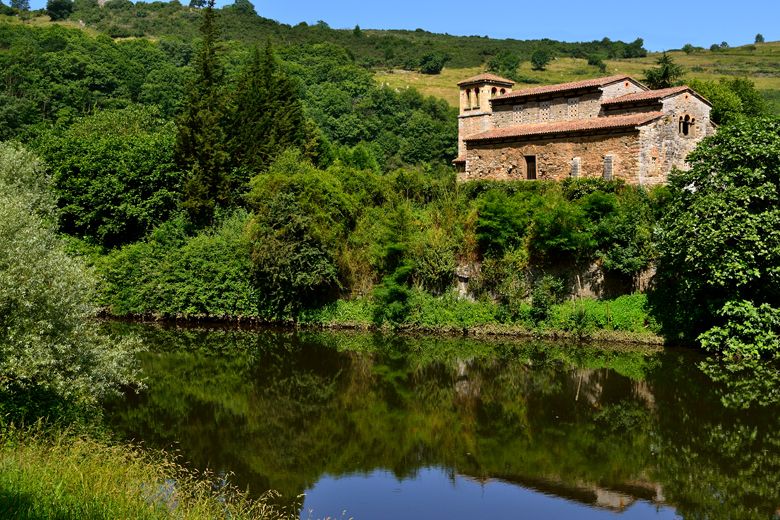
San Pedro de Nora is another of the legacies of the reign of Alfonso II, and like all the others, it has a privileged location, and allows you to take a walk of great cultural and scenic intensity: you can visit the Roman baths of Valduno, the meanders of the Nora - which are a wonderful natural spectacle -, stroll along the emblematic Gallegos Bridge and even chat with some pilgrims that you find on your way...
Santo Adriano de Tuñón, under the influence of the brown bear
From the magical effluvium of the Nora, you can head for the Trubia Valleys, and stop off in the town of Tuñón, where you will find the abbey of Santo Adriano de Tuñón, which was founded at the end of the 9th century by Alfonso III the Great and his wife Jimena, and is one of the last pre-Romanesque constructions erected during the two centuries of the Asturian monarchy.
Santo Adriano is set in a spectacular natural setting, close to the river and with the Senda del Oso (Bear Trail) as a faithful companion, which helps to enliven the area with lovers of hiking and cycling, as well as nature and culture enthusiasts. Tuñón has a year-round atmosphere as it is the start of the Senda del Oso, and has been home to a pre-Romanesque treasure for more than a thousand years.
Santa Cristina de Lena, the Crown Jewel
From the Trubia Valleys you can cross the Alto de La Cobertoria to La Pola, capital of the council of Lena, and from there to the beautiful church of Santa Cristina de Lena, which will be the last great landmark on your pre-Romanesque route.
Located in an idyllic spot, on the top of a hill, overlooking the valley of the river Lena, Santa Cristina seems to be timeless. Experts say that it was built in the 9th century, during the reign of Ramiro I.
The sweet Santa Cristina, known as the one with a thousand corners, due to the numerous inlets and protrusions in the frame of its reduced proportions, seems to be a guardian of the valleys, the mountains and the roads, those that have linked Asturias with the Meseta since time immemorial.
Observing her calmly, the same calm that she radiates, Santa Cristina (who appears in our cover photo) seems to whisper to you that she keeps unspeakable secrets?
And so, calmly, as you began, you will finish your route through Asturian Pre-Romanesque Art!
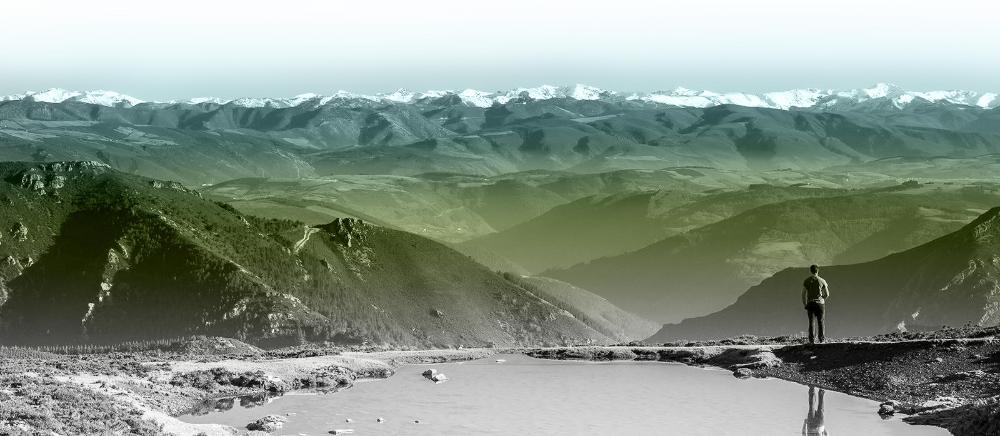
Subscribe to our newsletter and take advantage of offers, discounts, and news
Subscribe


